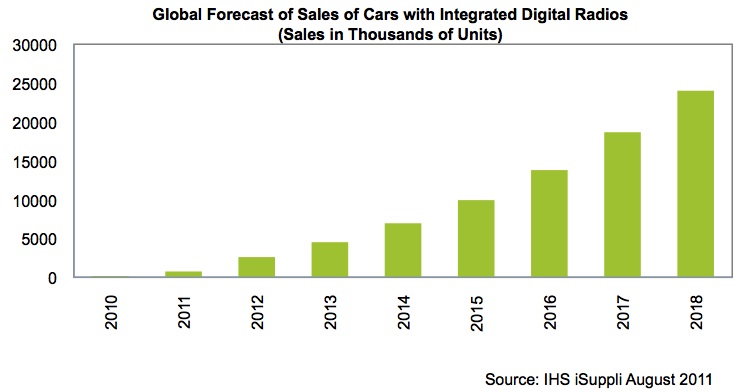 IHS iSuppli announced it forecasts that global sales of automobiles with Internet radio capability will rise thirty-fold during the next eight years.
IHS iSuppli announced it forecasts that global sales of automobiles with Internet radio capability will rise thirty-fold during the next eight years.
For more information visit: www.isuppli.com
Unedited press release follows:
Automotive Internet Radio Market Set to Boom
El Segundo, Calif., August 19, 2011—Global sales of automobiles with Internet radio capability are set to rise by a factor of more than 30 during the next eight years, leading a wave of in-vehicle apps that will be integrated into car electronics systems in the coming years, according to the IHS iSuppli Automotive Research Service from information and analysis provider IHS (NYSE: IHS).
Sales of cars with Internet radio integrated into their head unit will soar to 24 million units in 2018, up from 168,000 in 2010, as presented in the figure below. The United States will lead the Internet radio market, with sales growing to more than 10.9 million units in 2018, from 149,000 in 2010.
“The next several years will see an explosion in the use of in-vehicle apps in cars, driven by booming shipments of automobiles employing head units designed to integrate cloud-based content,” said Egil Juliussen, principal analyst for automotive infotainment at IHS. “These apps, whether built into cars or provided via connected mobile devices like smartphones, will provide a range of infotainment, entertainment, remote diagnostics and navigation services. With music having been the leading form of entertainment in cars for more than 75 years, Internet radio is expected to lead the in-vehicle app revolution.”
Head units head toward apps-based design
The explosion of Internet radio in vehicles is being enabled by fundamental shift in the way car electronics systems are being designed. Automotive infotainment systems are transitioning from fixed function head units to what IHS calls apps-based head units.
Similar to PCs, apps-based head units will be based on a software and hardware platform that will provide all functionality via applications. These apps will run on the head-unit platform and will supply a user interface based on the human machine interface (HMI) that OEMs have included in cars.
Smartphone integration software in head units allows drivers to tap into a vast amount of auto-related smartphone apps. The smartphone also provides a data plan for covering the cost of wireless communication to receive content and services. Only a few head units have some of these features today, but this approach will proliferate during the coming years.
Internet radio will be one of the apps most commonly used in apps-based head units.
Internet radio gets on the road
About 50 car models in the United States already have Internet radio app integration or will have it in their model-year 2012 versions. BMW, Ford, Lincoln, Mercedes-Benz, Scion, Buick, Chevrolet and Hyundai integrate Internet radio apps in the United States. In Europe, only BMW and Mini offer Internet radio so far. In China, there are four Chinese luxury models that are in the process of adding Internet radio integration.
Internet radio services go on the air
A range of Internet radio service providers have entered the U.S. market, including Pandora, iHeartRadio, Slacker and Spotify. These companies’ services represent direct competition to standard broadcast radio and subscription-based satellite radio.
Pandora is the de facto cloud-based Internet radio app among most OEMs and aftermarket head unit suppliers. For example, Pioneer made available a free PandoraLink app, which requires an appropriate aftermarket infotainment head unit to enable a wireless link between the head unit and the phone for Pandora radio integration.
Pandora makes its service available through a variety of distribution channels. In addition to streaming its service to PCs, Pandora has developed applications for smartphones and has partnered with the makers of more than 200 consumer electronics devices, including Alpine, Panasonic, Pioneer, Samsung and Sony.
Pandora also has developed relationships with major automobile manufacturers—including Ford, Mercedes-Benz and Mini—and with suppliers to major automobile manufacturers in order to integrate the service into current and future automotive sound systems. Furthermore, General Motors, Hyundai and Toyota have announced plans for future Pandora integrations.
Moving into the cloud
Beyond Internet radio there are a variety of other cloud-based sources of content. Cloud music locker services, such as Apple’s iCloud, Google Music or Amazon’s Cloud Drive will likely see implementation in the car due to the potential popularity of the approach in the mobile industry.However, at this point in time automotive OEMs have shown little interest in implementing this type of cloud service in the car. Instead, the trend is toward popular entertainment apps such as Pandora, iHeartRadio, Slacker and more.
To learn more about this topic, see the IHS iSuppli report entitled: “The Connected Car—In-Vehicle Apps for the Future.”
About IHS (www.ihs.com)
IHS (NYSE: IHS) is the leading source of information and insight in critical areas that shape today’s business landscape, including energy and power; design and supply chain; defense, risk and security; environmental, health and safety (EHS) and sustainability; country and industry forecasting; and commodities, pricing and cost. Businesses and governments in more than 165 countries around the globe rely on the comprehensive content, expert independent analysis and flexible delivery methods of IHS to make high-impact decisions and develop strategies with speed and confidence. IHS has been in business since 1959 and became a publicly traded company on the New York Stock Exchange in 2005. Headquartered in Englewood, Colorado, USA, IHS employs more than 5,100 people in more than 30 countries around the world.
